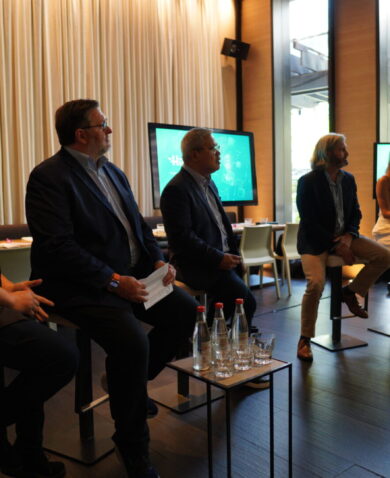
How to Stop Zoom Zone-Out: Lessons from VukaNow
March 11, 2021 | 4 Minute ReadOne year into the COVID-19 pandemic, with the shift to virtual engagements looking more permanent and increasing levels of “Zoom fatigue” being reported, empowering team members with the necessary tips and techniques to make these interactions a success remains essential.

The role of USAID’s VukaNow Activity is to catalyze learning and share information and best practices to enhance collaborative efforts to combat wildlife crime in southern Africa. This work requires many in-person meetings and workshops. In 2020, VukaNow, along with partner CollaborateUp, was organizing a critical learning event in Botswana, planned for mid-March. Just a few days before the event, with participants’ flights already booked, the Botswana government indicated that no one would be allowed to enter the country without quarantining for two weeks. That just wasn’t feasible. So, with only days to go, the team had to pivot the whole event to virtual.
This story probably echoes the experiences of many organizations, as a rapid shift to online meetings was rolled out all over the world. For VukaNow and CollaborateUp, this unexpected yet ultimately very successful shift to virtual engagement enabled the development of a strategy that can be extrapolated to other working environments.
Virtual Meetings — Changing More Than Just the Platform
Setting up virtual engagements requires fundamental shifts in the way events are planned, and this involves changing far more than just the platform. One of the purposes of most face-to-face meetings is to build relationships, and doing this on a virtual platform requires a new way of thinking. The traditional style of virtual engagements — simply broadcasting information through a series of one-way presentations — is perhaps adequate for imparting information, but when virtual meetings are the only possibility, it is necessary to take steps to ensure that participants are not just passive recipients of information, but actively engaged in the process.
CollaborateUp’s virtual event strategy guide was developed in August 2020. Almost a year later, much of what is advised in this strategy still holds true.
Preparing and designing your virtual event. Research shows that more than 80 percent of communication occurs nonverbally, and even with video conferencing, facilitators and participants lose much of the fidelity and ability to “read the room.” Meeting facilitators must be more deliberate in interactions with participants.
It’s often not possible for one person to carry out the role of ‘facilitator’ for a multi-session virtual meeting. CollaborateUp has found that the role of facilitator in virtual meetings needs to be split across two to three individuals — a facilitator, someone to monitor the chat box, and a ‘technical’ producer — to allow for a smooth, cohesive experience.
Breakout groups are an essential component of any meeting larger than 15 participants. While plenary sessions are ideal for sharing data and information, the real collaboration activities happen in breakouts.
Executing your virtual event. Studies show that participant attention begins to drift after seven minutes during a virtual meeting. Therefore, plan interactivity every seven to eight minutes. It doesn’t have to be groundbreaking; a small prompt to submit a question in the chat box, or a request to answer a poll can do the trick. Even better, call on people and draw them into conversation.
Encourage chit-chat and remember that side conversations in the online chat function bring value. Not only can they help replace the visual cues you normally rely on to moderate conversations, they keep people focused on the platform instead of multitasking.
Remember virtual meetings test our attention span and plan for shorter sessions. Participants should also get a mental ‘refresh’ at least every 90 minutes to two hours, even if it’s just a two-minute leg stretch.
Evolving Engagement
Although many of us may feel we are seasoned virtual meeting experts at this point, it is necessary to continue evaluating our approach, as people become fatigued by this kind of interaction.
We are now seeing increased push back from people about spending long hours in online sessions. Organizers should instead consider holding their events for shorter periods over more days. We are also seeing more hybrid approaches, with some sessions being pre-recorded while others are live. This can also enable organizers to reduce the time spent in formal sessions, by providing pre-recorded sessions ahead of time and allowing participants to watch these when it suits them prior to joining the live event.
At this stage, most organizations have made the decision on what platform to use and tend to stick with this. Instead of focusing on platform options, organizers are considering which add-on collaboration tools they will use, such as whiteboard functionalities, which can increase engagement. It is, however, essential to know your audience and take a balanced approach. A less tech-savvy audience may be intimidated by the introduction of new tools and engagement levels may decrease. If you decide to introduce a new technology to your meeting, consider sharing a tutorial with participants ahead of time and try using the technology for something fun, like an icebreaker, to start.
Lastly, a major change we are seeing involves the human element of virtual meetings. When the initial shift to online happened, there were high levels of empathy and tolerance for situations like pets or children interrupting meetings. As time has gone by, these levels of empathy have diminished, yet people’s circumstances have likely seen very little change. Re-energizing that kindness is something to consider.
Conclusion
As we continue to navigate the challenges of hosting virtual workshops and meetings, determining the best methods to keep these interactions engaging will allow organizations to operate more effectively. It is also important to remember that virtual engagements do not only pose challenges, they also offer a host of benefits, such as opening interactions to a wider audience, not limited by geographic location, and reducing costs associated with holding large events.
Posts on the blog represent the views of the authors and do not necessarily represent the views of Chemonics.
























